Other Affiliate Networks (with Custom Integration)
Learn how to integrate affiliate networks not available in the Integration Catalog using a Custom Integration.
While the AnyTrack Integration Catalog already includes integrations for most common affiliate networks, some users might wish to integrate networks not yet available in the catalog. While we cannot guarantee that these networks can be integrated, as we do not know if they accept tracking parameters or if they offer the ability to send postback notifications, this article presents a workaround using Custom Integration.
Prerequisites
- The affiliate network must be able to handle custom tracking parameters (such as the subid).
- The affiliate network must be able to send postback notifications with conversion data.
- Access to the website where the affiliate links are published is required, as you will need to manually append the tracking parameter placeholder to the links.
Setup Guide
1. Append tracking parameter to affiliate links.
Find out what the tracking parameter you affiliate network uses.
Append it with the placeholder to the links since autotag wont be able to identify these links
2. Install the Custom Integration
Sign in to your AnyTrack account and from the left menu navigate to Account: Integrations.
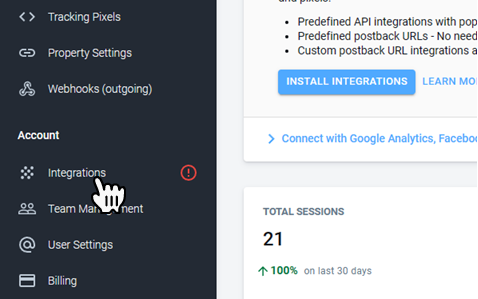
Click the + Add Integration button.
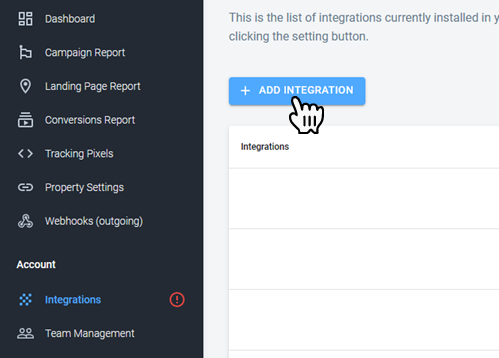
Type Custom in the search field and hit enter.

Click on the Custom integration.
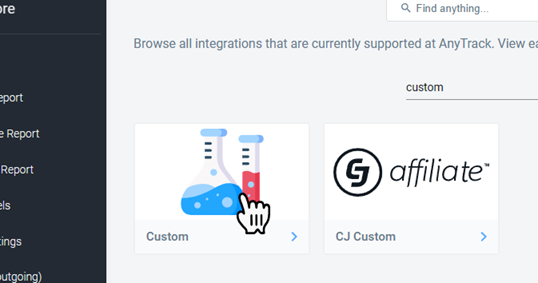
Click the Install Integration button in the integration screen.

Enter a Name for your custom integration in the Create Custom Integration form, leave the Login URL field empty, and click Create. This will open the Custom Integration page.
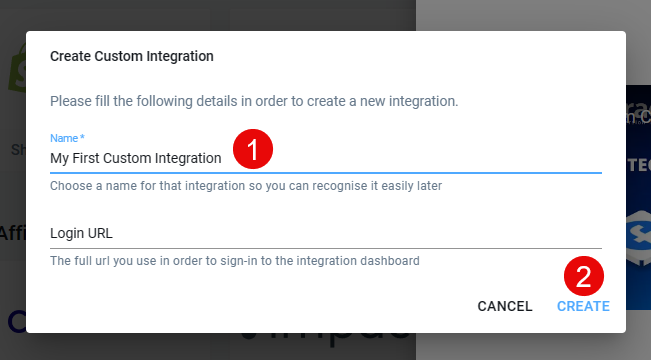
After completing the previous step, fill out the Generate a Postback URL Template page using the reference table of parameters (postback variables) below. This will be used to generate a customized URL that your conversion source will use to send the tracking parameters to AnyTrack.
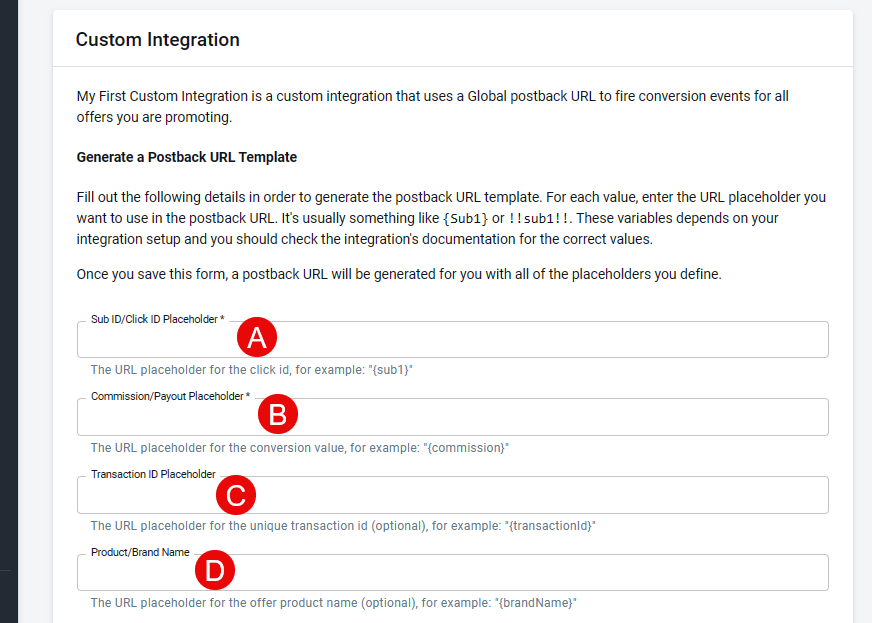
| Parameter | Definition | Value |
|---|---|---|
| A) Sub ID/Click ID Placeholder | Enter the parameter used by your affiliate network for tracking purposes. | examples include sub1, subid, tid, epi, etc. |
| B) Commission/Payout Placeholder | Enter the parameter used by your affiliate network for tracking the commission from the conversion. | example: commission, |
| C) Transition ID Placeholder | If available , Enter the parameter used by your affiliate network for tracking purposes. | example: transactionId |
| D) Product/Brand Name | Enter the parameter used by your affiliate network for tracking purposes. | example: itemName. brand Name |
Save your changes.
Copy the postback URL provided by the Custom Integration and install it on your affiliate network account according to their instructions
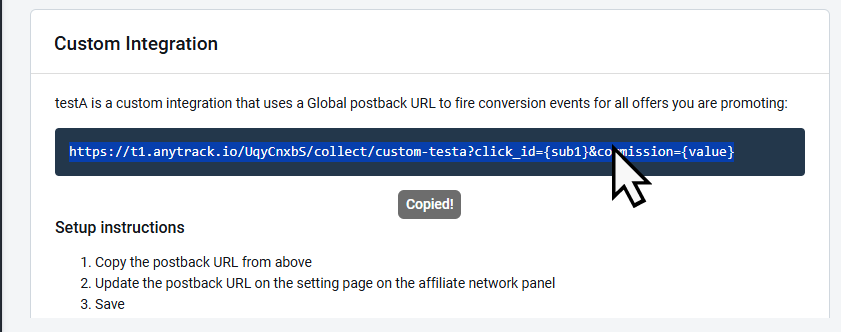
THe Custom Integration will provide a Postback URL. Install it on your affiliate network account according to their instructions.
Examples
Custom Conversion Source Integration Setup: Impact
See in action how to setup a custom conversion source with AnyTrack. In this video we use the Impact platform to illustrate how to integrate a custom conversion source using server-to-server communication.
Custom Conversion Source Integration Setup: HasOffers
In this second video we use the HasOffers platform to illustrate how to integrate a custom conversion source with AnyTrack, again using a Postback URL as the server-to-server connection method.
Connecting your conversion source with AnyTrack is essential in order to track conversions.
In case that you don't find your conversions source integration in our catalog, select the custom conversion source available in the catalog.
Good to know:
A conversion source is where the conversion takes place - a partner website, affiliate network, e-commerce platform, CRM, a course platform, etc.
Option #1 Server Side integration
If you're not familiar with the difference between Server Side and Client Side Tracking you should read more about server side tracking
Prerequisites:
- You need a webhook url from Zapier or Integromat - Learn more about [doc:webhooks].
- Generate a ClickID for your product links: our tracking method is based on creating ClickID for tracking the events on your website. By inserting the AnyTrack Tag into your website, AnyTrack will generate a
clickIdautomatically.
Client-side tracking
Check out the next tutorial about how to trigger standard events
To activate client side tracking you need to set the AnyTrack Tag on your website, and add the Event Snippet where you'd like to trigger the events.
For example, if you want to trigger a Lead event when a user reaches a "thank you" page, you'd want to add the following snippet on the thank you page.
This is an example of the “Lead” event snippet:
More examples of event tracking snippets are available in the custom event tracking article.
<script>
// trigger a lead event
var click_id = AnyTrack('trigger', 'Lead');
</script>
Or an OutboundClick followed by a redirect
<script>
<button type="button" onclick="handleBuyMe">Buy Me</button>
<script>
function handleBuyMe() {
var click_id = AnyTrack('trigger',
'OutboundClick');
window.location =
'https://some-store.com/?sub1=' +
encodeURIComponent(click_id);
}
</script>
Standard Events
You can change the event name with any of the [doc:standard-events] names.
What shall I do if I am not a programmer?
If you're not a programmer, the AutoScan function enables you to "click & define" your tracking settings, without writing a line of code.
How to use the AutoScan function:
- Navigate to the property settings
- Open the autoscan tab.
- Search the page where the element you'd like to track is.
- Decide which element or page you would like to mark as an event.
- Pick the relevant event name from the drop down menu.
Once you've updated the elements, anytrack will automatically track them and forward them to your Facebook Pixel / api and Google Ads via API according to your settings.
Updated 7 months ago

